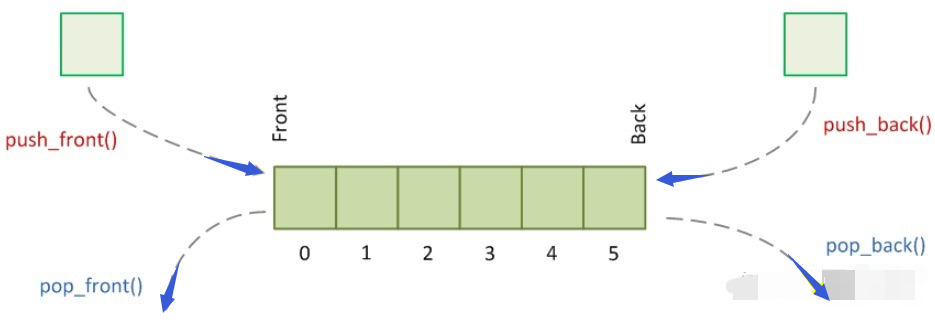SystemVerilog队列及数组方法,介绍内容如下:
- 队列
- 队列声明格式
- 队列的方法
- 队列的注意事项
- 队列举例
- 数组方法
6.1 数组缩减方法
6.2 数组定位方法
6.3 数组排序方法
队列
SystemVerilog引入了队列的数据类型,使用方便,性能上比动态数组好很多。
队列可以存储任意的数据类型,包括SystemVerilog内建的数据类型,也可以是用户自定义的数据类型。队列相当于维护了一个表格,其中表格可以实现任意的增删改查。
队列的顺序是由用户来维护的。
队列声明格式
SystemVerilog队列的声明格式为 data_type queue_name [$]。
例如,int data_q [ ] , 其 中 i n t 为 队 列 中 存 储 的 数 据 类 型 为 i n t 型 数 据 , 声 明 队 列 时 使 用 符 号 [ ],其中int为队列中存储的数据类型为int型数据,声明队列时使用符号[ ],其中int为队列中存储的数据类型为int型数据,声明队列时使用符号[]。
队列的方法
SystemVerilog队列提供了如下方法:
queue_name.size //返回queue的大小
queue_name.insert(index,item) //在index索引处插入item元素
queue_name.delete(index) //刪掉某元素或整个queue
queue_name.pop_front() //去除第一个元素(队首)
queue_name.pop_back() //去除最后一个元素(队尾)
queue_name.push_front() //插入元素到queue(0)(队首)
queue_name.push_back() //插入元素到queue($)(队尾)
其中,关于队列队首和队尾的方法,可以使用下图形象的了解和记忆
队列的注意事项
- 队列的存储空间无限大,理论上为物理内存的最大空间,从0到$。
- 可以在队列的任意地方实现元素的增删改查。
- 注意不要对队列使用构造函数new[]。
队列举例
int j = 1,
q2[$]={3,4}, // Queue literals do not use‘
q[$]={0,2,5}; // {0,2,5}
initial begin
q.insert(1, j); // {0,1,2,5} Insert 1before 2
q = {q[0:2],3,4,q[3]}; // {0,1,2,3,4,5}Insert queue in q
q.delete(1); // {0,2,3,4,5} Delete elem.#1
// These operations are fast
q.push_front(6);// {6,0,2,3,4,5} Insert at front
j = q.pop_back;// {6,0,2,3,4} j = 5
q.push_back(8);// {6,0,2,3,4,8} Insert at back
j = q.pop_front;// {0,2,3,4,8} j = 6
foreach (q[i])
$display(q[i]);// Print entire queue
q.delete(); // {} Delete entirequeue
end
本例中展示了队列的一些方法,首先声明了q2和q队列,后分别演示了insert/delete/push_front/push_bask等方法,其中每一行代码后的注释,说明了代码执行的结果。
int q[$] = {2, 4, 8};
int p[$];
int e, pos;
e = q[0]; // 读取第一个(最左边)条目。
e = q[$]; // 读取最后一个(最右边)条目。
q[0] = e; // 写第一个元素
p = q; // 读和写整个队列(拷贝)
q = {q, 6}; //在队列的尾部插入'6'
q = {e, q}; // 在队列的头部插入'e'
q = q[1:$]; // 删除第一个(最左边)元素
q = q[0:$-1]; // 删除最后一个(最右边)元素
q = q[1:$-1]; // 删除第一个和最后一个元素
q = {}; // 清除队列(删除所有的元素)
q = {q[0:pos-1], e, q[pos:$]}; // 在位置'pos'处插入'e'
q = {q[0:pos], e, q[pos+1:$]}; // 在位置'pos'之后插入'e’
本例展示了使用拼接符 {} 对队列进行操作,其执行结果如代码后的注释所示。
SV数组方法
SV提供了很多数组方法,这些方法用于任何一种非合并的数组类型,包括定宽数组,动态数组,队列和关联数组。这些方法有繁有简,种类繁多,包括求和,求积,排序等。
这些方法包括:
- 数组缩减方法:sum(求和)、product(求积)、and(与)、or(或)、xor(异或)
- 数组定位方法:
—min() //最小
—max() //最大
—unique() //唯一
—find() //returns all the elements satisfying the givenexpression.
—find_index() //returns the index of all the elements satisfying the given expression.
—find_first() //returns the first element satisfying the givenexpression.
—find_first_index() //returns the index of the first element satisfying thegiven expression.
—find_last() //returns the last element satisfying the givenexpression.
—find_last_index() //returns the index of the last element satisfying thegiven expression.
- 数组排序方法:sort、rsort、reverse、shuffle.
数组缩减方法
数组缩减方法包括:sum(求和)、product(求积)、and(与)、or(或)、xor(异或)
bit on[10]; // Array of single bits
int total;
initial begin
foreach (on[i])
on[i] = i;// on[i]gets 0 or 1
// Print the single-bit sum
$display(“on.sum =%0d”, on.sum);// on.sum =1
// Print the sum using 32-bittotal
$display(“on.sum =%0d”, on.sum +32’d0); // on.sum = 5
// Sum the values using 32-bits astotal is 32-bits
total = on.sum;
$display("total = %0d",total); // total = 5
// Compare the sum to a 32-bitvalue
if (on.sum>=32’d5) // True
$display("sum has 5 or more1’s");
// Compute with 32-bit signed arithimetic
$display("int sum=%0d", on.sum with (int’(item)));
end
上例演示了sum的使用方法,代码执行结果如注释所示。
int count, total, d[] = ‘{9,1,8,3,4,4};
count = d.sum with (item > 7); // 2: {9, 8}
total = d.sum with ((item > 7) * item); // 17= 9+8
count = d.sum with (item < 8); // 4: {1, 3, 4, 4}
total = d.sum with (item < 8 ? item : 0); // 12=1+3+4+4
count = d.sum with (item == 4); // 2: {4, 4}
上例主要演示 sum with的用法,执行结果如代码后注释所示。
byte b[] = ‘{ 1, 2, 3, 4};
int y;
y = b.sum ; // y becomes 10 => 1 + 2 +3 + 4
y = b.product ; // y becomes 24 => 1 * 2 *3 * 4
y = b.xor with ( item + 4 ); // y becomes12 => 5 ^ 6 ^ 7 ^ 8
logic [7:0] m [2][2] = '{ '{5, 10}, '{15, 20} };
int y;
y = m.sum with (item.sum with (item)); // y becomes 50 => 5+10+15+20
logic bit_arr[1024];
int y;
y = bit_arr.sum with ( int'(item) ); // forces result to be 32-bit
数组定位方法
int f[6] =‘{1,6,2,6,8,6};
int d[] = ‘{2,4,6,8,10};
int q[$] = {1,3,5,7}, tq[$];
tq = q.min();// {1}
tq = d.max();// {10}
tq = f.unique();// {1,6,2,8}
在本例中,min()为获取队列的最小值,max()为获取队列的最大值。unique()为获取唯一值。
注意:tq是一个队列,即本例中的数组方法返回一个队列。
int d[] = ‘{9,1,8,3,4,4}, tq[$]; // Find all elements greater than 3
tq = d.find_with (item > 3); // {9,8,4,4}
// Equivalent code
tq.delete();
foreach (d[i])
if (d[i] > 3)
tq.push_back(d[i]);
tq = d.find_index_with (item > 3); //{0,2,4,5}
tq = d.find_first_with (item > 99); // {} -nonefound
tq = d.find_first_index_with (item==8); // {2} d[2]=8
tq = d.find_last_with (item==4); // {4}
tq = d.find_last_index_with (item==4); // {5} d[5]=4
上例中,主要演示 find_with/find_index_with/find_first_with/find_last_with/find_first_index_with/find_last_index_with等的使用方法
注意:本例中tq为队列,即本例中的数组方法返回值为一个队列。
数组排序方法
int d[] = ‘{9,1,8,3,4,4};
d.reverse();// ‘{4,4,3,8,1,9}
d.sort();// ‘{1,3,4,4,8,9}
d.rsort();// ‘{9,8,4,4,3,1}
d.shuffle();// ‘{9,4,3,8,1,4}
reverse()为反转排序,即进行倒序排列,sort()为从小到大排列,rsort()为从大到小排列,shuffle()为打乱,进行随机排列。
最后
以上就是无限墨镜最近收集整理的关于IC学习笔记:05.SystemVerilog队列及数组方法【转载自知乎IC】的全部内容,更多相关IC学习笔记:05内容请搜索靠谱客的其他文章。








发表评论 取消回复